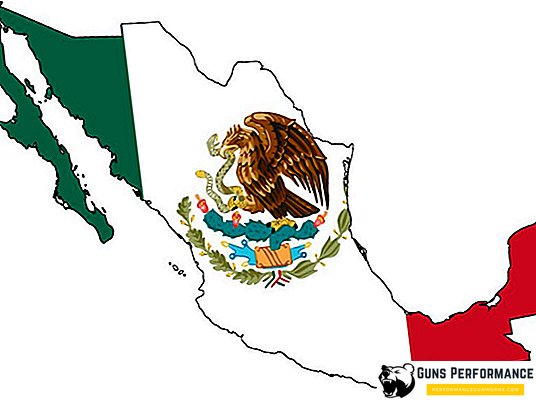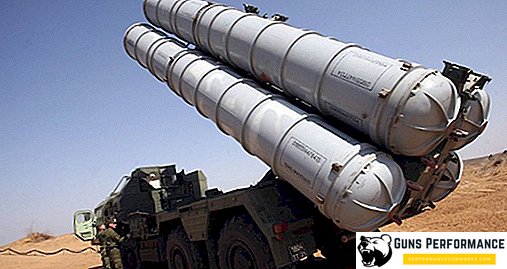In modern political history, the role of Mexico is estimated rather modestly, but one should take into account the rich past of this country, which dates back several thousand years. For centuries, the country has experienced ups and downs. This land remembers the great empires of the Aztecs and Mayans, sunk into oblivion under the onslaught of the Spanish colonialists. The period of Spanish rule, which lasted more than three hundred years, ended with the national liberation war of the Mexican people. At the site of the former colony an empire first arose. Then came the period of the Mexican Republic, instead of the emperor, the country received the presidency of Mexico, its own parliament and its own Constitution.

The path of Mexico from the Spanish colony to an independent state
Until the beginning of the XIX century, the territory of modern Mexico was considered the colonial possessions of the Spanish crown. Having overcome the resistance of the country's indigenous population, the Spaniards turned Mexico into their outpost on the North American continent. Since the time of Columbus, Mexico has been the resource base of the colonial empire, supplying the metropolis with cotton, sugar and coffee. All state power in the country was in the hands of the Governor-General, who represented the interests of the Spanish monarchs in these vast territories.

The events that shook Europe at the beginning of the XIX century, instantly reflected on the political life of the overseas colony of the Spanish kingdom. The once magnificent and vast empire could no longer resist the new realities that had arisen before the European political regimes with the coming to power of Napoleon. The invasion of French troops in Spain led to the fall of the centuries-old dynasty of the Spanish Bourbons. On the Spanish throne, Napoleon’s appointee, his brother Joseph, reigned. Overseas reacted vividly to the events in the metropolis. The royalists who supported the deposed King Ferdinand became more active. They were opposed by a party of liberals who advocated following Mexico in the wake of Napoleon’s policies. Despite pronounced conflicting political interests, supporters of both parties came to the conclusion that Mexico should be an independent state in these conditions.
With the silent consent of Madrid, on September 16, 1810, Mexico was declared an independent state. Following this act, a long and bloody national liberation war began, dividing the country's population and civil society into two camps with barricades. It should be recognized that the independence of Mexico was forged in the conditions of unceasing armed confrontation. Victories alternated with crushing defeats. After the revolutionary forces laid siege to the capital of Mexico, the Act of the Declaration of Independence of North America was adopted.

After the defeat of Napoleon in 1814, King Ferdinand VII returned to the throne in Madrid, having taken over the restoration of his ruined empire. Sending large contingents of Spanish troops to Mexico only added fuel to the fire. The revolutionary liberation movement unfolded with a new force, moving to guerrilla warfare.
For another eight long years, the country represented an arena of the most brutal civil armed conflict. At the final stage, Colonel Iturbide was among the leaders of the liberation movement. Spain by this time had completely exhausted the precious resources needed to continue a serious military campaign against the revolutionary forces. The revolutionary troops were also not in the best condition. As a result, the warring parties decided to sit down at the negotiating table, which ended with the signing of the Cordoba Treaty of August 24, 1821. From now on, Spain recognized the independence of Mexico. Just a month after the capture of the liberation army of Mexico City, Mexico was declared an Empire.

Iturbide was elected head of state, who by that time wore general shoulder straps. In the first months of Mexican independence, Iturbide served as president of the Regency Council (from August 1821 to May 1822). Subsequently, it was he who became the first Emperor of Mexico, who took the royal name Augustine I. The Parliament of Free Mexico approved the election of Iturbide as emperor, but this measure was recognized as temporary. The goals and objectives pursued by the political forces of the country, assumed the transfer of the throne to the Spanish monarch or person, representing one of the royal houses of Europe.
The history of the First Mexican Empire was transient. The military, led by the commander of the garrison of Veracruz, broke up a mutiny on December 1, 1822, declaring Mexico a republic. Even though the imperial troops defeated the rebels, civil society supported the appeals of the Republicans. In this situation, Emperor Augustine I was forced to resign from the powers of the head of state, thus completing the short period of the First Mexican Empire.

Mexico and the Republic
It should be recognized, as in most cases, the national liberation war in Mexico contributed to the expansion of state borders. The status of the empire spread to the vast territories of the New World. During the war years, Mexico significantly increased its territory, becoming one of the largest states on the political map of the world. At the time of the declaration of independence, the entire west coast of North America was under the jurisdiction of the new state. The current US states of Texas, California, Nevada, New Mexico and Utah in those years were considered the territory of Mexico. Similarly, the geopolitical map was formed in the South, where the Mexicans controlled El Salvador, Guatemala, Honduras and Nicaragua.

In October 1824, Mexico receives the first own Constitution, in accordance with which the country becomes a federal state. The head of state and the executive branch is now considered the president of Mexico, whose status is enshrined in the Basic Law. Liberal Democrat from among the authors of the new constitution Guadalupe Victoria October 10, 1824 becomes the first president of the Mexican Republic with authority for a period of five years.

If you do not take into account the short imperial period of the political history of Mexico, since the country gained its independence, the state power system in the state is divided into three stages:
- republican form of government, which existed from 1824 to 1863;
- The Second Empire, which existed just four years from 1863 to 1867;
- The recent history of Mexico, which began in 1867 with the fall of the empire and continues to this day.
Each of these periods was distinguished by the presence in the state’s policy of bright and charismatic leaders who, through their actions, made a huge contribution to the development of the Mexican state. Naturally, depending on the political situation in the world, the system of state power was also formed. In the country, a sharp domestic political struggle for power continued. Each of the political forces sought to gain an advantage over their opponents. In only forty years of the existence of the First Mexican Republic, the country received 50 presidents. Despite the rather long term of presidency, determined at five years, the heads of state were constantly changing. The main struggle in the domestic political arena unfolded between conservatives, liberals and conservative liberals.

Among the presidents of the period of the First Mexican Republic were also prominent personalities who left their significant mark in Mexican history. These can be safely attributed to Antonio Lopez de Santa Anna, who in Mexico is considered Napoleon of North America. It was under him that Mexico reached the highest peak of its power. Thanks to his high political and military qualities, this man eleven times became the president of Mexico. His first coming to power took place in May 1833, but a month later he was forced to leave his post due to the continuing internal armed confrontation. Subsequently, Santa Anna, relying on army bayonets, will be repeatedly returned to the highest public office. His last election to the presidency will take place 20 years later, in April 1853.

The last president of the First Mexican Republic was Benito Pablo Juarez, who, due to the prevailing military and political circumstances, in 1858 headed the country. It is he who holds the palm in the formation of the modern model of the Mexican state. Under his rule, the country received political reforms. Among his merits are reforms aimed at asserting the rights and freedoms of citizens. His draft of the Basic Law was taken as the basis of the new Constitution of Mexico, which was adopted in September 1857. Juarez, being at the head of the state and leading the executive power, sought to prevent the Republic from falling into the fire of the next civil war. The years of President Juárez’s reign can be considered the most prominent and significant in the new history of Mexico.
Wreck and Restoration of the Republic of Mexico
Despite the long existence of the First Mexican Republic, the country continued to remain a politically divided state. In 1863, in the conditions of the continuing military intervention of the French troops, conservatives came to power in Mexico - the party whose goal was to restore the Empire. During the first two years, during the so-called transition period, the country is headed by temporary presidents - representatives of the Conservative Party. Their task was to prepare the country for the return of the imperial political system.

The French Emperor Napoleon III creates a temporary junta, which determined the candidacy of the future monarch of Mexico. As compensation for the payment of a huge contribution, Napoleon III agreed to grant Mexico the status of an independent state. Since 1964, Mexico again became the Empire, and the second Emperor under the name of Maximilian I - the representative of the Austrian house of the Hapsburgs.
The existence of the Second Mexican Empire looked like an anachronism in the history of Mexico. In view of the stay of the French troops, the state administration system was disrupted. The political regime of Emperor Maximilian I rested entirely on French bayonets. However, France could no longer, due to political complications, continue military intervention. In the face of the impending military conflict in Europe with Prussia Bismarck, Napoleon III made a decision in 1866 in the withdrawal of French troops from Mexico. In a similar situation, the question arose of the further expediency of preserving the monarchical regime in the country. Having received support from the assembly of the notables, which spoke in favor of preserving the power of the Emperor, Maximilian I decided to continue the armed struggle against the strengthened Republicans.
Despite the rather powerful armed force, Emperor Maximilian lost an armed confrontation. The fate of the second Emperor of Mexico was tragic. The former emperor, captured by the rebels, was executed on May 18, 1867 by the verdict of the military-field court. With such a cruel gesture, Mexico once and for all departed from its monarchical past. Benito Pablo Juarez is once again becoming the new head of state.
This lasted for almost half a century the period of political vacillation from the monarchy to the republican form of government ended. Mexico finally acquires the status of the Republic, and the legally elected presidents become heads of state.

Presidents of Mexico since 1867 to the present day
The coming to power of Benito Juarez marked the return of Mexico to the ranks of democracies. It cannot be said that the established political regime in the country was ideal, but a certain sequence began to be traced in terms of state power. Heads of state differently came to power. At certain moments, the country again experienced an internal political crisis, during which the presidents alternated with the frequency of a pendulum. From 1867 to this day, Mexico was headed by 37 presidents. One can judge about political affiliation by looking at the list of presidents who in different years occupied an important government post:
- In the second half of the XIX century, the presidents of the Republic were: Benito Pablo Juarez, Sebastian Lerdo de Tejada, José Maria Iglesias, Porfirio Dias, Juan Nepomuceno Mendez and Manuel González. Liberal Porfirio Díaz three times became president of Mexico. With him the country entered the twentieth century;
- In the first half of the 20th century, Mexico was led by the following persons: Francisco Ignacio Madero, Pedro Lascuraine, Jose Victoriano Huerta Ortega, Francisco Carvajal, Eulalio Gutierrez, Roque González Garza, Francisco Lagos Cházaro, Venustiano Carrans, the Apollo Company, the Apollo Company, the Apollo Gonsalez Garza, Francisco Lagos Chasaro, Venustiano Carrans, the Apollo Company, the Apollo Company, the Apollo Graça, Francisco Lagos Chasaro, Venustiano Carrans, the Apollo Company, the Apollo Company, the Apollo Graça , Emilio Portes Gil, Pascual Ortiz Rubio, Abelardo Rodriguez, Lazaro Cardenas, Manuel Avila Camacho and Miguel Aleman Valdés.


The latter accepted the country in December 1946 and remained as president until November 1952. The second half of the 20th century, the so-called modern history of the institution of the President of Mexico, is associated with the tenure of the following persons on the highest state post:
- Adolfo Ruiz Cortines took office in December 1952 and remained in office until November 1958;
- Adolfo López Mateos was elected to the presidency in December 1958. He remained president for six years until November 1964;
- Gustavo Diaz Ordaz held the highest state post from December 1964 to November 1970;
- Louis Echeverria became president of Mexico in 1970 and remained in office until November 1976;
- José López Portillo - years of government 1976-1982;
- Miguel de la Madrid came to power in December 1982. He held a high post until November 1988;
- Carlos Salinas became head of state on December 1, 1988 and held a high position until November 1994;
- Ernesto Zedillo - President of the Republic of Mexico from 1994-2000;
- Vicente Fox is the representative of the National Action Party, who in December 2000 becomes president of Mexico. He holds the post until the end of office in November 2006;
- Felipe Hinojosa Calderon - reign 2006-2012;
- Enrique Peña Nieto is the current president of the Republic of Mexico. Elected in December 2012.

Heads of state who held a high post after Miguel Alemán Valdés and before Ernesto Zedillo represented the only political force - the Institutional Revolutionary Party. The one-party system adopted in Mexico after the end of the Second World War left its mark on the methods of government.
Only with the beginning of the new millennium, the hegemony of one party was eliminated. The last three presidents of the country represent two different political forces: the Party of National Unity and the Institutional Revolutionary Party.

Powers of the current President of Mexico
Under current conditions, the head of state has quite broad powers. Unlike other democracies, in Mexico, the current president is not eligible to remain in office for two consecutive terms. The election is carried out for a six-year term, after which the head of state becomes the honorary president of the country. Presidential elections are held by secret ballot in one round, the winner is determined by a majority vote.

После подсчета голосов победитель принимает присягу на верность народу Мексики и Конституции страны. Инаугурация вновь избранного главы государства происходит в стенах мексиканского парламента.
Заступая на высокий пост, президент берет на себя функции главы исполнительной власти. В его компетенции назначение на высокие государственные должности, обеспечение функционирования всего государственного аппарата. В соответствии с Конституцией страны президент Мексики обладает правом законодательной инициативы, тем более, что по мексиканской политической традиции большинство законодательных актов исходит из кабинетов исполнительной власти. В отличие от других стран с демократической формой правления, в Мексике глава государства в состоянии полностью контролировать законотворческий процесс. Указы и декреты, исходящие от президента страны имеют силу закона.

По Конституции Мексики действующий глава государства является Верховным главнокомандующим вооруженных сил Мексиканской Республики. В его компетенции также находится право объявлять в стране военное и чрезвычайное положение. Президент представляет страну на международной арене и обладает самыми широкими полномочиями на подписание международных договоров и соглашений.












